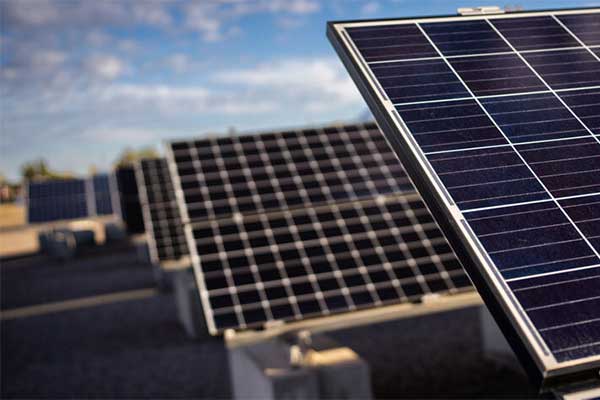- Photovoltaics researchers at Sandia completed a five-year degradation study of 834 fielded photovoltaic modules.
- The researchers measured the performance degradation of the modules in New Mexico, Colorado and Florida.
- They found that degradation rates are highly nonlinear over time, and seasonal variations were present in some module types. Six out of 23 systems studied had rates that would exceed the warranty limits in the future.
A team led by photovoltaics researchers at Sandia has completed a five-year degradation study of 834 fielded photovoltaic modules, representing 13 types of modules from seven manufacturers in three climates. Their objective was to quantify degradation rates of recent, widely used photovoltaic technologies and release results publicly to inform relevant stakeholders and best practices.
The team’s Progress in Photovoltaics article gives the results of their study and represents years of work at Sandia’s Photovoltaic Systems Evaluation Laboratory and partnering labs at the National Renewable Energy Laboratory and the University of Central Florida.
“The PV market is continuously changing, and there is a lack of long-term field data for these newer technologies, which raises the question whether durability has been affected or not,” team lead Marios Theristis said.
“Purchasing PV modules directly from the open market allows us to conduct an unbiased analysis and inform the public in an onymous manner by also releasing the data. Partnership with NREL and UCF was imperative for such a study because it enabled us to install identical systems in different climates and characterize them following a well-controlled and harmonized measurement plan.”
According to the researchers, the cost of photovoltaic modules has declined sharply (by up to 85% according to one recent NREL report) in the last decade, thanks to economies of scale, the use of new, higher efficiency cell designs, automation of production lines, larger modules and changes to the bill of materials, like thinner glass and frames, new encapsulants and backsheets, and more.
However, those cost-saving changes to module designs and materials could affect module durability and reliability, and the levelized cost of electricity is sensitive to the power degradation rate. As power degradation increases, the levelized cost of electricity rises and system lifetime falls.
The scientists measured the performance degradation of the fielded photovoltaic modules in New Mexico, Colorado and Florida. They measured performance under standard test conditions at the start of the study, examined initial power stabilization and periodically retested the modules over the following five years to monitor degradation rates over time.
They found that degradation rates are highly nonlinear over time, and seasonal variations were present in some module types. Mean and median degradation rate values of -0.6% per year were consistent with rates measured for older modules. Of the 23 systems studied, the study found that six had degradation rates that would exceed the warranty limits in the future, whereas 13 systems demonstrated the potential of achieving lifetimes beyond 30 years, assuming degradation rate trends have stabilized.
“This is an encouraging outcome. With the increasing installations of photovoltaics, consumers and other stakeholders will be interested to learn that PV durability appears to be consistent in the face of rapid technology improvements and cost reductions,” Marios said.
“However, it is also concerning that 26% of the systems might exceed the warranty limits. Opportunities still exist to reduce degradation rates to levels that enable even longer PV module lifetimes. For example, for 35- and 50-year lifetimes, PV modules should operate at degradation rate values greater than -0.55% per year and -0.4% per year, respectively.”
The scientists also raised important points for discussion. How the degradation rate is defined, whether relative to specifications or initial post-stabilization rating, can influence the resulting rate. This resulting rate may have significant influence on purchase costs, warranty and insurance claims or feasibility studies for project financing.
Marios said consumers and stakeholders interested in learning more about the modules tested will soon be able to view all flash test data collected at Sandia, the National Renewable Energy Laboratory and the University of Central Florida’s Florida Solar Energy Center at DuraMAT DataHUB.
“This study is a great example of how the national laboratories are working together with universities to answer critical questions about the durability of solar energy technologies,” said Sandia senior scientist Joshua Stein. “Few institutions are able to sustain long-duration experiments involving such a large number of modules.”
“We continue to deploy new technologies as they become available in the market,” Marios said. “Therefore, we will continue to report on all PV lifetime stages, and we will also leverage the field measurements, along with imaging data, to give attributes to what drives degradation and why.”
—
Publication Referenced in the Article:
Marios Theristis et al, Onymous early‐life performance degradation analysis of recent photovoltaic module technologies, Progress in Photovoltaics: Research and Applications (2022). DOI: 10.1002/pip.3615
—
This article was written by the team at DOE’s Sandia National Laboratories.









Comments